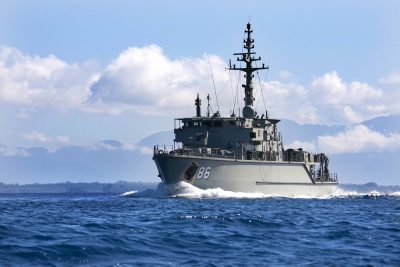Fatuous Defence: Australia’s Guided Missile Plans

All Global Research articles can be read in 51 languages by activating the “Translate Website” drop down menu on the top banner of our home page (Desktop version).
***
Even in times of pandemic crises, some things never change. While Australia gurgles and bumbles slowly with its COVID-19 vaccine rollout, there are other priorities at stake. Threat inflators are receiving much interest in defence, and the media is feeding on it with a drunken enthusiasm. We live in a dangerous environment, and think-tankers, parliamentarians and commentators are starting to get a sweet taste for imminent conflict.
The latest instalment in this pitiable train towards conflict was revealed in Canberra last month. Australia, it seems, wants to make its own guided missiles. In a joint statement, the Prime Minister and Ministers for Industry and Defence outlined the enterprise. “The Morrison government will accelerate the creation of a (AU)$1 billion Sovereign Guided Weapons Enterprise, boosting skilled jobs and helping secure Australia’s sovereign defence capabilities.”
Australian Prime Minister Scott Morrison outlined his views in a media release on March 31. “Creating our own sovereign capability on Australian soil is essential to keep Australians safe, while also providing thousands of local jobs in business right across the defence supply chain.”
In making the announcement, he opted for a chalk and cheese comparison. “As the COVID-19 pandemic has shown, having the ability for self-reliance, be it in vaccine development or the defence of Australia, is vital to meeting our own requirements in a changing global environment.” That specious idea ignores the point that the weapons are going to be made, not by Australian arms companies (they can barely even manage any credible local production) but by foreign entities.
Australia’s Department of Defence is on the hunt for a “strategic industry partner”, which, in all likelihood will be one of the giants such as Raytheon Australia, BAE Systems Australia or Lockheed Martin Australia. The mere fact that such companies have tagged Australia at the end of their antipodean corporate base is no reassurance about a local killing capability. But the newly appointed Defence Minister Peter Dutton gives the impression that the selection will be somehow competitive and balanced, promising to resort to a “Smart Buyer” process in picking the said partner. Such smartness is bound to be bereft of any intelligence, as with previous procurement deals that go pear shaped within a matter of months. (At this writing, the Australian-Naval Group future submarine contract is sinking under incompetence, disagreement and cost.)
Dutton praises the idea of having an Australian base for the manufacture of such guided weapons, as they will “not only benefit and enhance our ADF operational capacity but will ensure we have adequate supply of weapon stock holdings to sustain combat operations if global supply chains are disrupted.” Given Australia’s poor performance in coping with disruptions to the supply of COVID-19 vaccines, despite the propaganda about sovereign capability in that field, this is actually mildly amusing.
We already know from government mutterings that the US will be crucial (when is it not?) in feathering the Australian project, giving it a faux independence. The Australian Strategic Policy Institute, heavily commercialised, compromised and bound to the US-Australian insecurity complex, prattles constantly about the need to get involved with useless machinery that only serves to inspire the arms manufacturers of other countries.
Take this number from Andrew Davies from last month, thinking that it might not be such a bad idea to get on board the hypersonic weapons bandwagon. Australia, he suggested, “might well join” the major powers in acquiring them. The country, he claims, has “some world class researchers”. The nub: Australians have been “in joint programs with the US for over 20 years.”
The announcement about guided missiles excited ASPI’s director of defence, strategy and national security, Michael Shoebridge, a man who has been salivating for a proper war for some few years now. The latest initiative was “being driven by the two Cs, China and COVID.” Shoebridge fantasises about long-range anti-ship missiles and new vehicles with missile capabilities. In June last year, he warned of “a glaring gap we must close in our ability to supply the Australian Defence Force with precision munitions – notably missiles. Advanced missiles give the militaries the edge in combat.” His nightmare: Australian impotence in the face of supply disruptions; a slow production rate from overseas sources; abandonment. This is particularly more acute given that Australia is no longer interested in peacekeeping missions. Blame, he says, “the deteriorating strategic environment in our region” – a real favourite expression in the Prime Minister’s office and ASPI.
With Canberra making it clear that it wishes to continue a hissing and booing campaign against China even as it ingratiates Washington, the entire process has a heavy tang of needless stupidity. As to whether it actually benefits Australia in any concrete sense, a clue is offered by Dutton. “We will work closely with the United States on this important initiative to ensure that we understand how our enterprise can best support both Australia’s needs and the growing needs of our most important military partner.” If that is sovereign capability and independence, one hates to think what vassalage looks like.
*
Note to readers: please click the share buttons above or below. Forward this article to your email lists. Crosspost on your blog site, internet forums. etc.
Dr. Binoy Kampmark was a Commonwealth Scholar at Selwyn College, Cambridge. He lectures at RMIT University, Melbourne. He is a frequent contributor to Global Research and Asia-Pacific Research. Email: [email protected]

